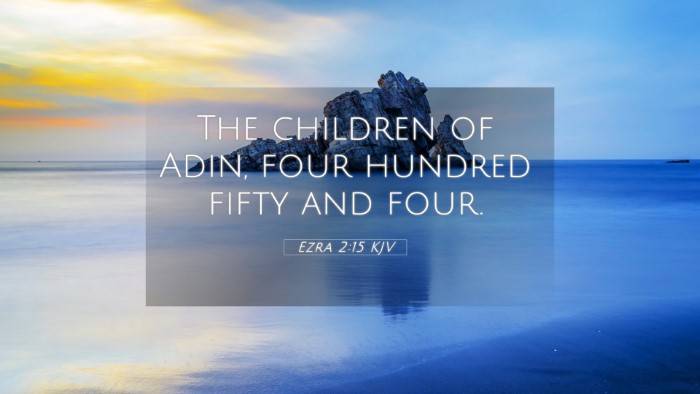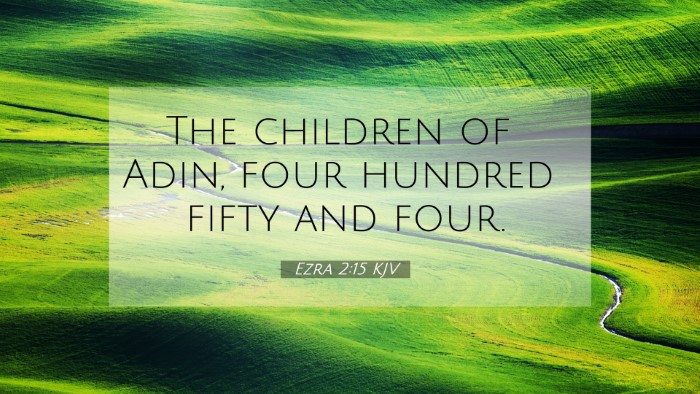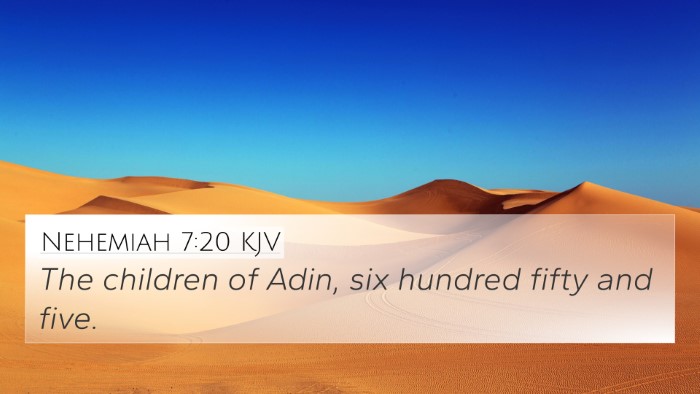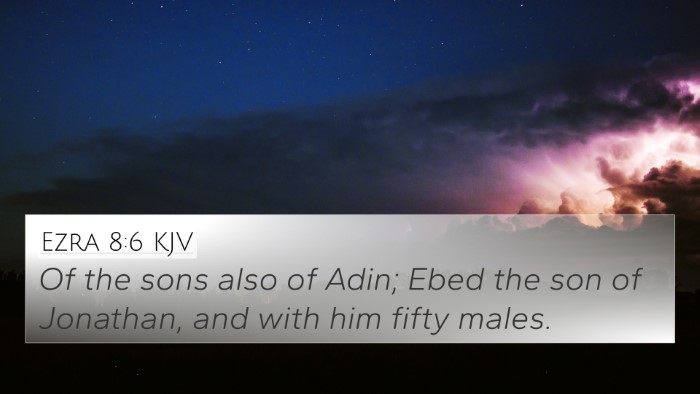Understanding Ezra 2:15
Ezra 2:15 states: “The children of Jodah, the children of the priests, the children of the Levites, and the children of the Nethinims also came, and the children of Solomon's servants.” This verse contributes to the broader narrative of the returning exiles from Babylonian captivity, indicating the groups involved in the restoration of Jerusalem. The verse’s significance lies in its depiction of the diverse community that would collaborate in re-establishing their homeland and worshiping God.
Commentary Insights
- Matthew Henry: In his commentary, Henry emphasizes the importance of the different groups mentioned. He highlights that God's people are not monolithic; they come from various backgrounds, each with distinct roles and significance in the rebuilding of Jerusalem. The unity in diversity among the returning exiles is a powerful reminder of collective purpose under God's calling.
- Albert Barnes: Barnes focuses on the specific mention of the “Nethinims” and the “children of Solomon’s servants.” He explains their historical context as temple servants appointed for various tasks related to the service of worship. This illustrates the continuity of service and the commitment of the people in all aspects of community life, including spiritual duties, reaffirming the idea that every contribution, no matter how small, is valuable in God’s plan.
- Adam Clarke: Clarke draws attention to the organization of the returning exiles and the records of their lineage. He believes that such genealogical details are critical in establishing identity and heritage, which were highly valued in ancient Israel. This meticulous record also serves as a testament to God’s faithfulness across generations, calling believers to remember their roots.
Main Themes
This verse encapsulates several important themes:
- Community and Inclusion: The different groups signify that God's work involves all people, encouraging unity and collaboration among diverse individuals.
- Service and Ministry: The mention of temple servants highlights the importance of dedicated service in worship and the maintenance of spiritual life in the community.
- Heritage and Identity: The genealogical lists serve to remind the community of their history and the faithfulness of God from generation to generation.
Cross References
This verse connects thematically and literally to several other Bible verses:
- Nehemiah 3:16: Discusses the repair of the walls of Jerusalem by the sons of Hasenah, highlighting community effort.
- 1 Chronicles 9:2-3: Lists the inhabitants of Jerusalem who returned, emphasizing the varied backgrounds and roles.
- Ezra 3:8: Mentions the Levites and priests who came to Jerusalem, illustrating the immediate focus on re-establishing worship.
- Ezra 6:16: Celebrating the dedication of the temple by the returning exiles, pertinent to the gathering of diverse groups.
- 2 Chronicles 36:23: A call by King Cyrus for the restoration of the temple and the return of the exiles, underscoring divine orchestration.
- Matthew 10:5-6: While mentioning the apostles' mission to specific groups, it reflects broader themes of purpose and community in ministry.
- Revelation 21:24: Describes the nations walking by the light of the New Jerusalem, showcasing a vision of unified worship extending across diversity.
How to Use Cross-References
Utilizing cross-references such as those listed can provide deeper insights into individual verses and greater context for scriptural themes. Here are some tools and methods for effective cross-referencing:
- Bible Concordance: Use this tool to find related verses that share themes or keywords.
- Cross-reference Bible Study Methods: Organize your study around a particular theme and track how verses relate to each other.
- Bible Reference Resources: Utilize guides and resources that compile verses with similar themes to explore in detail.
Conclusion
Ezra 2:15 serves as a microcosm of the larger narrative of God's people returning and reconstructing their community and worship. The insights drawn from public domain commentaries and the cross-references underscore the rich theological connections woven throughout Scripture, encouraging believers to consider how these ancient texts are still relevant today. Through linking Bible scriptures and understanding the community aspects of faith, one can appreciate the importance of belonging and service in the body of Christ.




